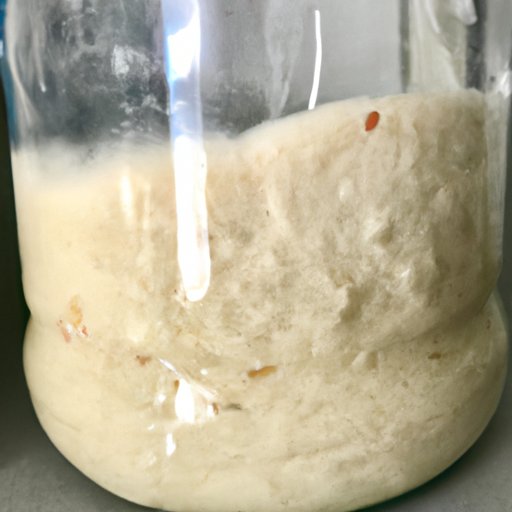
Introduction
There’s nothing more disappointing than preparing to bake a delicious sourdough bread, only to realize that your starter has gone bad. If you’re new to working with starters, it might be tricky to identify when your starter has gone awry. However, keeping an eye out for the following signs could prevent you from ruining your baked goods. In this article, we’ll discuss six tell-tale signs that your starter is bad and what you can do to salvage it.
Identifying a Foul Odor
Fermented starter has a distinct sour smell; however, a foul, putrid odor can indicate that something unpleasant is happening. The aroma could remind you of vomit, sweaty socks, or even glue. These smells occur due to bacterial growth or fermentation gone wrong. It could indicate that the microorganisms in the starter have switched from producing lactic acid (which gives the characteristic sour taste and smell) to butyric acid (which results in an unpleasant odor).
If you notice a foul odor in your starter, you don’t need to throw it away. Instead, scoop off any discolored or dried-up parts from the surface and discard them. Next, feed your starter with fresh flour and water, and let it ferment. Monitor the aroma over subsequent feedings. It should improve with time and gradually become sour again.
Dense Texture or Inconsistency
A healthy starter should be light and airy. It should also bubble and increase in volume after feeding. A dense, pancake-batter-like texture is often a warning sign that the starter has gone bad. Similarly, inconsistency in texture is also a cause of concern. It could result from over or underfeeding the starter, contamination with other bacteria, or using non-sterilized equipment.
To prevent a dense texture or inconsistency, ensure that you keep a consistent feeding schedule. Always measure your ingredients and use a clean jar and utensils. To fix a dense starter, reduce the amount of flour and water you add. Instead, start with a small feeding and gradually increase the quantities over subsequent feedings.
Loss of Activity
The activity of a starter refers to the puffy, bubbly appearance and the rate at which it increases in volume. A starter with low activity will not rise correctly during baking, resulting in dense bread. A starter with no activity, meaning it doesn’t bubble or rise, is a sign of bad bacteria or yeast that have caused the starter to die.
You can revive a starter that has lost activity by increasing the hydration rate through more frequent feeding. It’s also worth checking the temperature and location of your starter. A starter that is too cold will take longer to rise, while one that is too hot will over-ferment quickly, leading to unpleasant smells or flavors.
Visible Mold
While mold growth is rare in sourdough starters, it can happen due to several reasons. Mold spores can come from contaminated flour, fruits, or vegetables added to the starter, exposure to the air, or a non-sterilized container or utensils. Mold appears as patches of blue-green, white, or black growth on the surface of the starter and its surroundings.
If you notice mold, do not try to salvage the starter. Mold growth can spread quickly to the whole batch and cause health hazards. Instead, dispose of the entire starter, clean the container and utensils in hot, soapy water, and begin afresh with a new starter.
Change in Color
When healthy, starters should have a light beige to yellow hue due to the presence of lactic acid bacteria that produce pigments. On the other hand, a dark, brownish color indicates spoiled or dead bacteria. The color change could be due to high acidity, over-fermentation, or the presence of contaminants.
To prevent a change in color, avoid overfeeding your starter and keep it at a comfortable temperature. If you notice a color change, consider discarding it and starting with a fresh batch.
Sour Smell
A sourdough starter should smell sour. However, an overpowering acidic smell could be a warning sign that something’s amiss. High acidity levels can result from over-fermentation, high temperatures, or the use of low-quality flour.
To adjust the acidity of your starter, change the frequency or quantity of feeding. You can also try using a combination of different flours in your starter to influence the acid production.
Conclusion
By knowing the signs and symptoms of a bad starter, you can prevent the frustration and disappointment that comes with failed baking attempts. Watch for the warning signs of foul odors, dense texture, loss of activity, visible mold, changes in color, or sour smells. If you’re struggling to maintain your starter, don’t give up. Sometimes it can take a few tries to get the perfect texture and taste. But with patience and care, you can enjoy a delicious sourdough bread made with a healthy and active starter.





